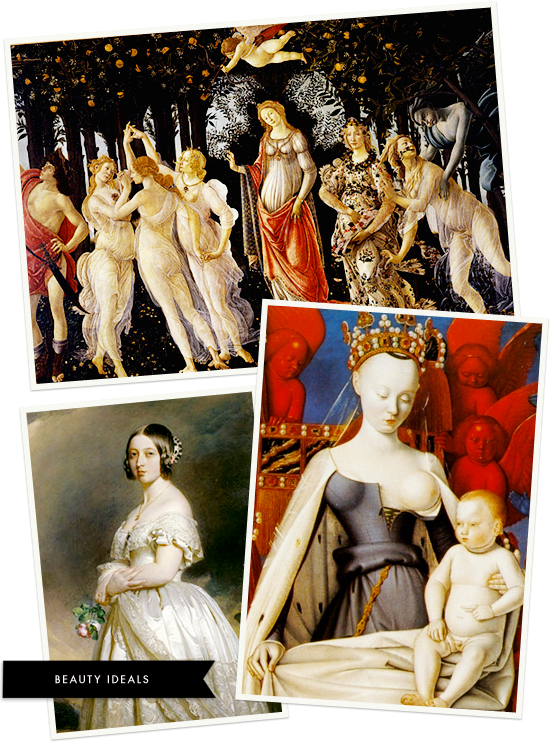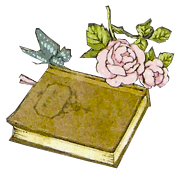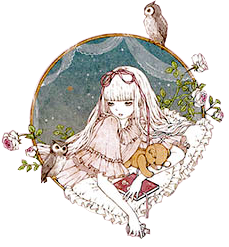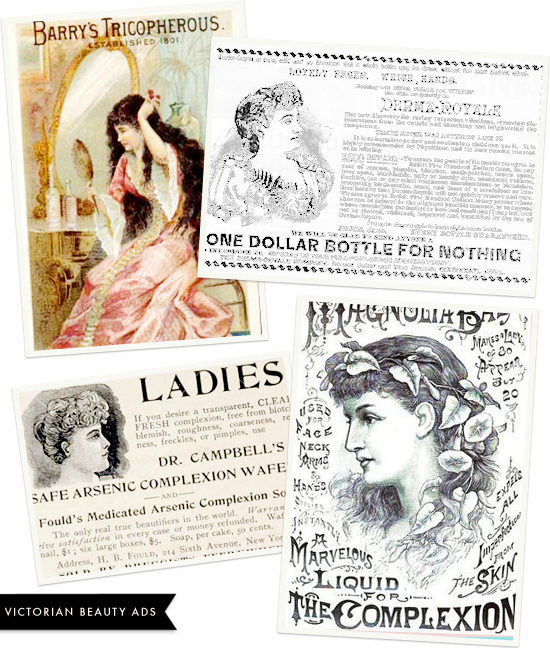Beauty is only skin deep
mercredi 16 avril 2014
Beauty ideals evolved a lot through the course of history. For instance, a woman considered "beautiful" nowadays would have been deemed as "ugly" according to the 17th century standards when being "plump" was a sign of good health and "pale", a sign of nobility and wealth.
I don't pretend to write a very elaborate entry about the evolution beauty ideals through the ages as whole books have been written on the subject already. But I just wanted to share some of my discoveries concerning make-up and generally "crazy" and unealthy things women would do for the sake of being considered "beautiful".
 Antiquity beauty ideals
Antiquity beauty ideals
Light skin has almost always been considered beautiful as it was a sign of your rank in society (only the ones who had to work to earn their living had tanned kin) and it was indeed the case in Greek/Roman/Egyptian times. To make their skin look whiter/paler, women used foundation made of a mix of fat, oil and white lead or Venetian ceruse.
The problem is that lead and ceruse are highly toxic and can cause very heavy damage to your body, causing among other health hazards: scars, damage to your nervous system, brain disorders and plain blood poisoning due to the accumulation of lead in your body through your skin.
 Middle Ages & Renaissance beauty ideals
Middle Ages & Renaissance beauty ideals
Pale skin was a must for noble ladies (just as it was before). Showing your hair and applying makeup were considered "sinful" and associated with prostitutes and actresses. But noble and wealthy women sometimes used foundation mixed with mercury (another highly poisonous metal). And some went so far as to bleed themselves to appear paler! Medieval women would also pluck or shave their forehead and eyebrows to widen their brow as it was considered beautiful.
Agnès Sorel, mistress of French king Charles VII, was considered as the most beautiful lady of her times (see below, bottom right picture) and she died of Mercury poisoning after giving birth. Some considered she had been vonluntarily poisoned but it rather seems that she ingested a lot of heavy metals during her life such as mercury or gold which were considered to be good for health and beauty (which was indeed not the case).

Beauty ideals during Renaissance (Primavera), Middle Ages (Agnès Sorel) and Victorian era (queen Victoria)
 18th century & Victorian beauty ideals
18th century & Victorian beauty ideals
Pale skin is still a must. As you can see in the Victorian ads below, most of the foundation used during the Victorian era was highly poisonous, mixing arsenic, mercury with lead. The use of these poisonous mix raised concern among the medical community as it caused some women's death!
Dilated pupils were also considered as beautiful and attractive, so women used belladonna drops to make their pupils bigger but it caused visual distortion, increased heart rate and even blindness if used regularly.
 Interesting links to learn more about beauty ideals
Interesting links to learn more about beauty ideals
-
Evolution of corsetry and its impact on health.
-
Suffering for beauty - Killer cosmetics through the ages.
-
Regency cosmetics.
-
History of beauty review of Umberto Ecco's book.
-
Victorian era beauty tips for the lolita.
So, what's your opinion about all of this. Nowadays, women still do pretty "crazy" and unealthy things to appear beautiful (examples:
1 -
2 -
3 and many more...). Any thoughts about this?
Libellés : fashion, history
Beauty is only skin deep
Beauty ideals evolved a lot through the course of history. For instance, a woman considered "beautiful" nowadays would have been deemed as "ugly" according to the 17th century standards when being "plump" was a sign of good health and "pale", a sign of nobility and wealth.
I don't pretend to write a very elaborate entry about the evolution beauty ideals through the ages as whole books have been written on the subject already. But I just wanted to share some of my discoveries concerning make-up and generally "crazy" and unealthy things women would do for the sake of being considered "beautiful".
 Antiquity beauty ideals
Antiquity beauty ideals
Light skin has almost always been considered beautiful as it was a sign of your rank in society (only the ones who had to work to earn their living had tanned kin) and it was indeed the case in Greek/Roman/Egyptian times. To make their skin look whiter/paler, women used foundation made of a mix of fat, oil and white lead or Venetian ceruse.
The problem is that lead and ceruse are highly toxic and can cause very heavy damage to your body, causing among other health hazards: scars, damage to your nervous system, brain disorders and plain blood poisoning due to the accumulation of lead in your body through your skin.
 Middle Ages & Renaissance beauty ideals
Middle Ages & Renaissance beauty ideals
Pale skin was a must for noble ladies (just as it was before). Showing your hair and applying makeup were considered "sinful" and associated with prostitutes and actresses. But noble and wealthy women sometimes used foundation mixed with mercury (another highly poisonous metal). And some went so far as to bleed themselves to appear paler! Medieval women would also pluck or shave their forehead and eyebrows to widen their brow as it was considered beautiful.
Agnès Sorel, mistress of French king Charles VII, was considered as the most beautiful lady of her times (see below, bottom right picture) and she died of Mercury poisoning after giving birth. Some considered she had been vonluntarily poisoned but it rather seems that she ingested a lot of heavy metals during her life such as mercury or gold which were considered to be good for health and beauty (which was indeed not the case).

Beauty ideals during Renaissance (Primavera), Middle Ages (Agnès Sorel) and Victorian era (queen Victoria)
 18th century & Victorian beauty ideals
18th century & Victorian beauty ideals
Pale skin is still a must. As you can see in the Victorian ads below, most of the foundation used during the Victorian era was highly poisonous, mixing arsenic, mercury with lead. The use of these poisonous mix raised concern among the medical community as it caused some women's death!
Dilated pupils were also considered as beautiful and attractive, so women used belladonna drops to make their pupils bigger but it caused visual distortion, increased heart rate and even blindness if used regularly.
 Interesting links to learn more about beauty ideals
Interesting links to learn more about beauty ideals
-
Evolution of corsetry and its impact on health.
-
Suffering for beauty - Killer cosmetics through the ages.
-
Regency cosmetics.
-
History of beauty review of Umberto Ecco's book.
-
Victorian era beauty tips for the lolita.
So, what's your opinion about all of this. Nowadays, women still do pretty "crazy" and unealthy things to appear beautiful (examples:
1 -
2 -
3 and many more...). Any thoughts about this?
Libellés : fashion, history
The legend of Briar Rose
"The fateful slumber floats and flows
About the tangle of the rose."

 평화 [pʰjəŋ.hwa]
평화 [pʰjəŋ.hwa]
Child of the 80's born in Seoul (South Korea) - Living and working in Paris (France) - Languages spoken: French / English (surprise surprise, despite my place of birth I don't speak or understand a word of Korean!) - Languages studied but not practiced enough to speak them fluently: Spanish / Japanese / Latin (not spoken anymore anyway) / Ancient Greek - Studied: History / specialised in French Medival History -




















 평화 [pʰjəŋ.hwa]
평화 [pʰjəŋ.hwa]
Enregistrer un commentaire
1. Comments are moderated.
2. Please don't post spam/advertisements, or your comment won't be published.
3. At last, thanks for your comment!